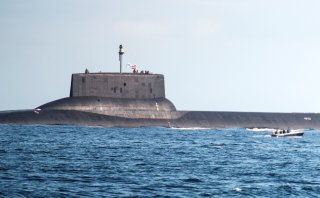‘The Hunt for Red October’ Is a Submarine Movie Masterpiece
“Ramius and his men are depicted as fully dimensional people, equals to their American counterparts. The film essentially lays the Cold War to rest.”
In 1984 the U.S. Naval Institute Press published Tom Clancy’s techno-thriller The Hunt for Red October. Six years later Die Hard-director John McTiernan adapted the book into a movie starring Sean Connery and Alec Baldwin.
The book is a masterpiece. The movie is, if anything, better. Streamlined and shorn of technological jargon compared to its source material, McTiernan’s film is an intimate character study masquerading as a military adventure.
Connery plays Marko Ramius, captain of the Soviet navy’s experimental Typhoon-class ballistic-missile submarine Red October. On the year anniversary of his wife’s death Ramius steers his nuclear-armed boat west toward the United States. He aims to defect.
The Soviet fleet gives chase. NATO misreads the naval mobilization as a prelude to war and deploys its own forces. Just one man, Baldwin’s bookish CIA analyst Jack Ryan, understands Ramius’s true intentions. Baldwin must convince military leaders to give Ramius a chance.
“The Hunt for Red October is about a man of letters up against men of action,” Priscilla Page, a Los Angeles writer, wrote in an April 2020 essay.
Jack Ryan is an academic who must prove himself to politicians, generals, admirals, judges -- men who deal in war daily and can only read strategy, conflict and destruction into Ramius’s seemingly inscrutable actions.
But Jack Ryan knows Ramius, explaining to Admiral Greer (James Earl Jones) that he wrote the bio on Ramius just the year before. It’s supremely satisfying to watch Ryan figure him out: excitedly talking to himself, interrupting powerful men, doing pitch-perfect impressions of these men, intuiting emotion and intent just by studying the data.
When Jack Ryan considers the rogue Red October, he doesn’t perceive an enemy or a prelude to war because he’s sussed out something deeper in Ramius. He sees his humanity. A man trying to defect, to make peace.
In a film populated by men who are isolated, literally submerged and invisible to each other as they play naval hide-and-seek, Jack Ryan sees Marko Ramius.
Where contemporary thrillers emphasized action over character, The Hunt for Red October delays any real action until its final act, Page pointed out. “Until its last 15 minutes, most of the action is mental, not physical. Ryan’s task isn’t to disable a bomb or duke it out with terrorists, it’s to persuade.”
It’s testimony to Clancy’s book, the film script by John Milius, Larry Ferguson and Donald Stewart that the movie is so engaging despite the dearth of action. The characters propel it. The story’s historical context lends it weight.
“Motives that at first felt complicated and impossible to ascertain turn out to be incredibly human, simple, relatable,” Page wrote. “It’s a film that is radical in its empathy and marks a dramatic shift in movies.”
“Though set in 1984, its attitudes reflect 1990, the year of its release. This is the era of Gorbachev, glasnost, perestroika. The Russians depicted here are a far cry from Cold War-era supervillains like Ivan Drago in Rocky IV or From Russia With Love’s Rosa Klebb.”
“Ramius and his men are depicted as fully dimensional people, equals to their American counterparts. The film essentially lays the Cold War to rest.”
David Axe is defense editor at The National Interest. He is the author of the graphic novels War Fix, War Is Boring and Machete Squad.

